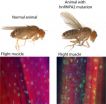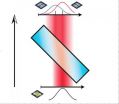(Press-News.org) An international group of researchers has discovered seven new regions of the human genome—called loci—that are associated with increased risk of age-related macular degeneration (AMD), a leading cause of blindness. The AMD Gene Consortium, a network of international investigators representing 18 research groups, also confirmed 12 loci identified in previous studies. The findings are reported online today in the journal Nature Genetics. Supported by the National Eye Institute (NEI), a part of the National Institutes of Health, the study represents the most comprehensive genome-wide analysis of genetic variations associated with AMD.
"This compelling analysis by the AMD Gene Consortium demonstrates the enormous value of effective collaboration," said NEI Director Paul A. Sieving, M.D., Ph.D. "Combining data from multiple studies, this international effort provides insight into the molecular basis of AMD, which will help researchers search for causes of the disease and will inform future development of new diagnostic and treatment strategies."
AMD affects the macula, a region of the retina responsible for central vision. The retina is the layer of light-sensitive tissue in the back of the eye that houses rod and cone photoreceptor cells. Compared with the rest of the retina, the macula is especially dense with cone photoreceptors and is what humans rely on for tasks that require sharp vision, such as reading, driving, and recognizing faces. As AMD progresses, such tasks become more difficult and eventually impossible. Some kinds of AMD are treatable if detected early, but no cure exists. An estimated 2 million Americans have AMD.
Scientists have shown that age, diet, and smoking influence a person's risk of developing AMD. Genetics also plays a strong role. AMD often runs in families and is more common among certain ethnicities, such as Asians and people of European descent.
Since the 2005 discovery that certain variations in the gene for complement factor H—a component of the immune system—are associated with major risk for AMD, research groups around the world have conducted genome-wide association studies to identify other loci that affect AMD risk. These studies were made possible by tools developed through the Human Genome Project, which mapped human genes, and related projects, such the International HapMap Project, which identified common patterns of genetic variation within the human genome.
The AMD Gene Consortium combined data from 18 research groups to increase the power of prior analyses. The current analysis identified seven new loci near genes. As with the previously discovered 12 loci, these seven loci are scattered throughout the genome on many different chromosomes.
"A large number of samples was needed to detect additional genetic variants that have small but significant influences on a person's disease risk," said Hemin Chin, Ph.D., NEI associate director for ophthalmic genetics, who assembled the consortium and helped coordinate the study. "By cataloging genetic variations associated with AMD, scientists are better equipped to target corresponding biological pathways and study how they might interact and change with age or other factors, such as smoking."
The consortium's analysis included data from more than 17,100 people with the most advanced and severe forms of AMD, which were compared to data from more than 60,000 people without AMD. The 19 loci that were found to be associated with AMD implicate a variety of biological functions, including regulation of the immune system, maintenance of cellular structure, growth and permeability of blood vessels, lipid metabolism, and atherosclerosis.
"Like a map that identifies neighborhoods where the electricity has been knocked out by a storm, the AMD Gene Consortium's study effectively tagged regions within the genome where researchers are most likely to find short circuits in DNA that cause AMD," said Anand Swaroop, Ph.D., chief of the NEI Laboratory of Neurobiology and Neurodegeneration and Repair, and one of the group leaders of this consortium effort. "Once you are in the right neighborhood, going block to block or house to house to look for downed power lines goes much faster. Likewise, by limiting their search to the 19 genomic regions identified by the AMD Gene Consortium, scientists can more efficiently search for specific genes and causative changes that play a role in AMD."
As with other common diseases, such as type 2 diabetes, an individual person's risk for getting AMD is likely determined not by one but many genes. Further comprehensive DNA analysis of the areas around the 19 loci identified by the AMD Gene Consortium could turn up undiscovered rare genetic variants with a disproportionately large effect on AMD risk. Discovery of such genes could greatly advance scientists' understanding of AMD pathogenesis and their quest for more effective treatments.
###
Lead authors of the study include Gonçalo R. Abecasis, D. Phil., University of Michigan, Ann Arbor; Lindsay A. Farrer, Ph.D., Boston University; Iris Heid, Ph.D., University of Regensburg, Germany; and Jonathan L. Haines, Ph.D., Vanderbilt University, Nashville.
For more information about AMD, visit http://www.nei.nih.gov/health/maculardegen/index.asp.
This research was supported in part by the NEI Intramural Research Program and NIH grants Z01EY000475, U10EY006594, R01EY015810, R01EY015286, R03EY013438, R01EY010605, R24EY017404, R01EY014458, R01EY017362, R24EY017404, R01EY013834, K23EY000365, R01EY009611, R01EY021532, R01EY021163, R01EY013435, R24EY019861, P30EY019007, T32EY021453, R01EY012118, R01EY022005, R01EY016862, R01EY014467, K12EY16335, R01EY11309, R01EY09859, R01EY014428, R01EY018660, R01EY019270, U54HG006542, P01CA87969, R01CA49449, and R01HL35464.
The National Eye Institute, part of the National Institutes of Health, leads the federal government's research on the visual system and eye diseases. NEI supports basic and clinical science programs that result in the development of sight-saving treatments. For more information, visit http://www.nei.nih.gov.
About the National Institutes of Health (NIH): NIH, the nation's medical research agency, includes 27 Institutes and Centers and is a component of the U.S. Department of Health and Human Services. NIH is the primary federal agency conducting and supporting basic, clinical, and translational medical research, and is investigating the causes, treatments, and cures for both common and rare diseases. For more information about NIH and its programs, visit http://www.nih.gov.
NIH...Turning Discovery Into Health®
March 3, 2013— (Bronx, NY) — Researchers at Albert Einstein College of Medicine of Yeshiva University have discovered how the most common genetic mutations in familial Parkinson's disease damage brain cells. The study, which published online today in the journal Nature Neuroscience, could also open up treatment possibilities for both familial Parkinson's and the more common form of Parkinson's that is not inherited.
Parkinson's disease is a gradually progressing disorder of the nervous system that causes stiffness or slowing of movement. According to the Parkinson's ...
PHILADELPHIA – A multi-institution group of researchers has found new candidate disease proteins for neurodegenerative disorders. James Shorter, Ph.D., assistant professor of Biochemistry and Biophysics at the Perelman School of Medicine, University of Pennsylvania, Paul Taylor, M.D., PhD, St. Jude Children's Research Hospital, and colleagues describe in an advanced online publication of Nature that mutations in prion-like segments of two RNA-binding proteins are associated with a rare inherited degeneration disorder affecting muscle, brain, motor neurons and bone (called ...
Researchers at the University of Rochester and the University of Ottawa have applied a recently developed technique to directly measure for the first time the polarization states of light. Their work both overcomes some important challenges of Heisenberg's famous Uncertainty Principle and also is applicable to qubits, the building blocks of quantum information theory.
They report their results in a paper published this week in Nature Photonics.
The direct measurement technique was first developed in 2011 by scientists at the National Research Council, Canada, to measure ...
HOUSTON – Cancer vaccines that attempt to stimulate an immune system assault fail because the killer T cells aimed at tumors instead find the vaccination site a more inviting target, scientists at The University of Texas MD Anderson Cancer Center report in Nature Medicine.
A common substance used in many cancer vaccines to boost immune attack betrays the cause by facilitating a buildup of T cells at the vaccination site, which then summon more T cells to help with the perceived threat.
"Vaccines stimulate production of T cells primed to attack the target cancer, and ...
A study led by St. Jude Children's Research Hospital has discovered mutations in two genes that lead to the death of nerve cells in amyotrophic lateral sclerosis (ALS), also known as Lou Gehrig's disease, and related degenerative diseases.
The same mutation occurred in both genes and led to the abnormal build-up of the proteins inside cells. These proteins play an essential role in normal RNA functioning and have also been linked to cancer, including the Ewing sarcoma, the second most common type of bone cancer in children and adolescents. The finding is the latest in ...
Scientists have produced an instruction manual for the human genome that provides a framework to better understand the relationship between an individual's genetic make-up and their lifestyle.
The international team of researchers say their study – published in Nature Biotechnology – provides the best model yet to explain why individuals react differently to environmental factors such as diet or medication.
"This research is the second important stage of our understanding of the human genome," said study author Professor Pedro Mendes, from The University of Manchester's ...
A team of researchers from Johns Hopkins Children's Center, the University of Mississippi Medical Center and the University of Massachusetts Medical School describe the first case of a so-called "functional cure" in an HIV-infected infant. The finding, the investigators say, may help pave the way to eliminating HIV infection in children.
A report on the case is scheduled for presentation at a press conference on Sunday, March 3, at the 20th Conference on Retroviruses and Opportunistic Infections (CROI) in Atlanta. Johns Hopkins Children's Center virologist Deborah Persaud, ...
Building on earlier pioneering work by researchers at the University of California, San Diego, an international consortium of university researchers has produced the most comprehensive virtual reconstruction of human metabolism to date. Scientists could use the model, known as Recon 2, to identify causes of and new treatments for diseases like cancer, diabetes and even psychiatric and neurodegenerative disorders. Each person's metabolism, which represents the conversion of food sources into energy and the assembly of molecules, is determined by genetics, environment and ...
MADISON — A multi-university team of researchers has artificially engineered a unique multilayer material that could lead to breakthroughs in both superconductivity research and in real-world applications.
The researchers can tailor the material, which seamlessly alternates between metal and oxide layers, to achieve extraordinary superconducting properties — in particular, the ability to transport much more electrical current than non-engineered materials.
The team includes experts from the University of Wisconsin-Madison, Florida State University and the University ...
(Boston) – An international group of researchers has discovered seven new regions of the human genome—called loci—that are associated with increased risk of age-related macular degeneration (AMD), a leading cause of blindness. The AMD Gene Consortium, a network of international investigators representing 18 research groups, also confirmed 12 loci identified in previous studies. The study, which is published online in Nature Genetics and represents the most comprehensive genome-wide analysis of genetic variations associated with AMD, was supported by the National Eye Institute ...


